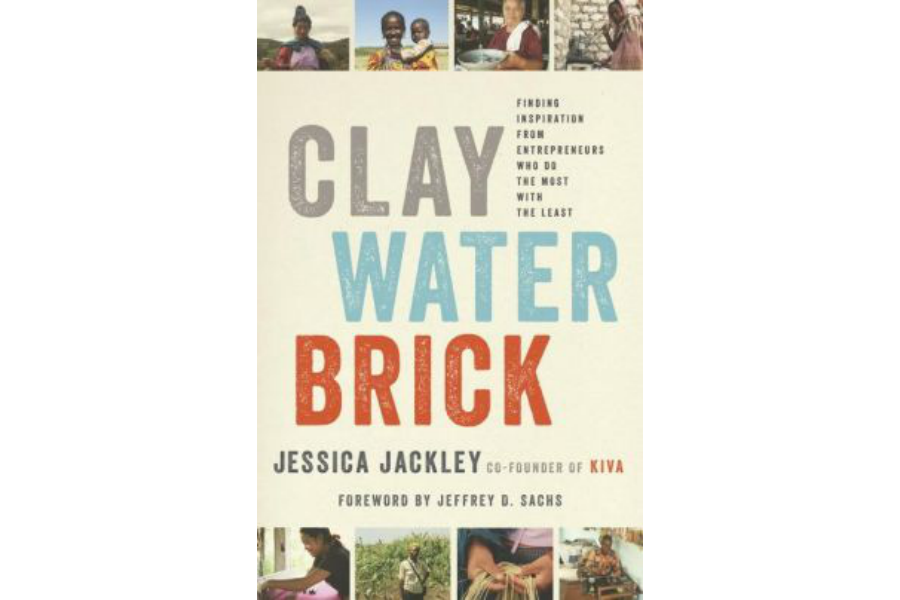‘Clay Water Brick’ explores the spirit of entrepreneurship
Loading...
Jessica Jackley was just a child when the concept of poverty first entered her world. Five and a half years old, sitting attentively on the floor of her Sunday School, she learned about Jesus' demand to help “the least.” Up through her teens, that demand spoke to Jackley as an eternal homework assignment, pushing her to raise funds, volunteer, and donate, even as a growing frustration impelled her to seek a more lasting solution.
Clay Water Brick is Jackley's memoir about the years she has spent investigating possibilities to end global poverty. Along the many paths that Jackley has traveled, she has met inspirational figures from the West, but says she has been most helped by the people she has worked with in poverty-stricken countries. In 2005, Jackley and her then-husband Matt Flannery founded Kiva, a groundbreaking non-profit that matches individuals and groups willing to offer micro-loans – sometimes as little as $25 – with would-be entrepreneurs needing exactly that amount to start a business. The impressive payback rate on Kiva loans is nearly 99%. With Kiva, Jackley found her answer to fighting poverty.
Jackley's journey toward founding Kiva arrived at a turning-point on the campus of Stanford University (where she would go on to earn a degree from the Stanford Graduate School of Business). While working in an office on campus, Jackley took advantage of the opportunity to attend talks and to speak informally to willing professors about their work. When she heard Nobel Prize laureate Muhammad Yunus speak on the founding of the Grameen Bank – the microfinance organization and community development bank Yunus founded in Bangladesh – her view of the poverty-stricken was transformed. “These were not weak, helpless people," she writes. "These were people who were capable, tenacious, and resourceful. These were people I wanted to be around, not people I wanted to avoid.”
She got her chance when she met the executive director of the Village Enterprise Fund, a nonprofit that focused on building local and sustainable businesses in East Africa. Speedily, Jackley was hired and sent into the field. As Jackley traveled and had the chance to talk with the entrepreneurs who built enterprises with the help of a micro-loan, her ideas about microlending crystallized.
She writes, for instance, about a woman whose first purchase from her microloan was sugar. The reason? She wanted to be able to put sugar in the tea of any guests who would visit her – a gesture that offered her empowerment and prestige. For Jackley, the encounter helped to solidify her understanding that the entrepreneurs and not the lenders are the best judges of their own needs. “[T]he heart of entrepreneurship," Jackley writes, "is never about what we have. It’s about what we do.”
After working for Village Enterprises for a while, she and Flannery decided to take the plunge and begin their own organization. In the beginning, the challenges facing Kiva were enormous. “None of our earliest staff had salaries for months or more; for better or worse, I didn’t take one for over two years," writes Jackley. "Somehow we made it work.” Until they provided the option for lenders to donate $1 of each loan to the organization, Kiva's small band of employees often faced empty refrigerators as they struggled to live on donations raised offline from friends and family.
Kiva eventually grew into a respected nonprofit, but the organization's new status did not mean its challenges were over. One of the biggest hurdles they faced was coping with a major fraud on the part of one of their intermediaries in East-Africa, which stole more than $25,000 from them. However, they chose to treat the incident with complete transparency, informing their clients in full and paying lenders back from their own bank accounts.
They faced a different kind of crisis when they were offered $10 million by a well-known tech company to pass to entrepreneurs in need. The money was very tempting, but accepting it would have meant sacrificing the personal connection Kiva makes between lender and entrepreneur. So, to stay true to Kiva's mission, they turned the money down.
In the beginning of each chapter Jackley gives voice to a different entrepreneur she has met through her travels. The book starts with the story of Patrick the Brickmaker, who teaches Jackley how to see potential where others see nothing by making bricks out of what he had – earth and water. One of the stories teaches by negative example. Fatuma the Charcoal Seller buries her steadily growing income in the ground instead of using it to create a better life. From Fatuma, Jackley learns not to honor security over risk-taking.
"Clay Brick Water" is the memoir of a woman blessed with natural curiosity, dedication, and possibly a healthy portion of insanity. It's the kind of insanity that lands men on the moon or first crosses the Atlantic in a plane – in other words, the insanity of the risk-taker.
Jackley fills her book with anecdotes and emotional context. However, her narrative provides little in the way of the history and economic theory behind entrepreneurship. Readers looking for academic context will have to seek elsewhere.
Instead, Jackley's main intent seems to have been to produce pages that would cheer and empower the reader, and in that she has certainly succeeded.







